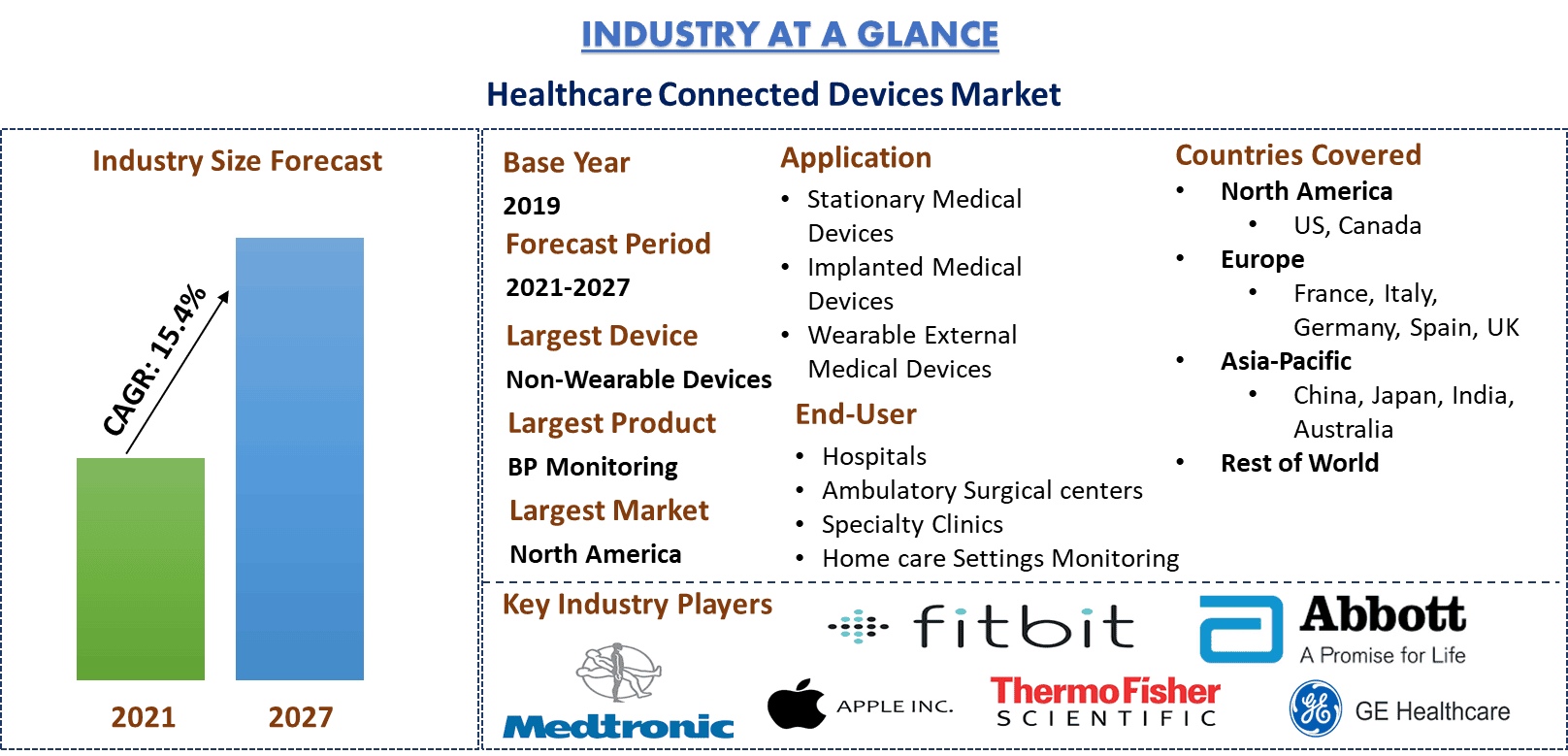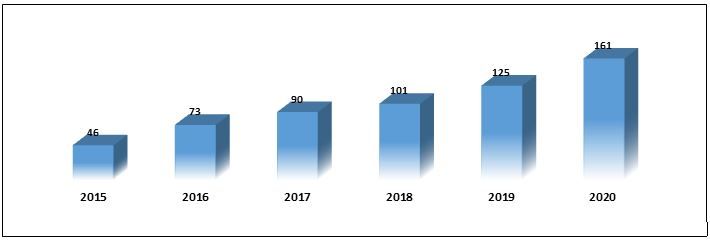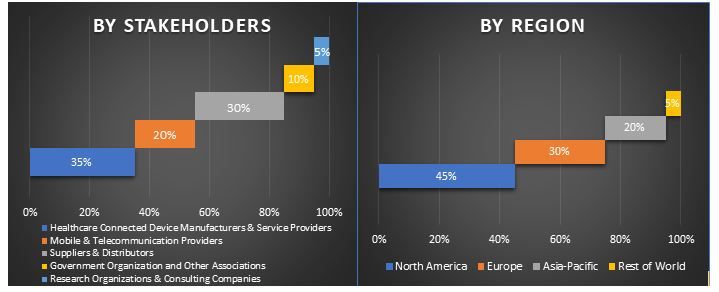- Home
- About Us
- Industry
- Services
- Reading
- Contact Us
Healthcare Connected Devices Market: Current Analysis and Forecast (2020-2027)
Emphasis on Device (Wearable, Non-Wearable); Product (BP Monitor, ECG Monitoring Device, Glucose Monitor, Heart Rate Monitor, Insulin Pump, Portable GPS PERS, Pulse Oximeter, Smart Pill Dispenser); Application (Stationary Medical Device, Implanted Medical Device, Wearable External Medical Device); End-users (Hospitals, Ambulatory Surgical Centers, Specialty Clinics, Home Care Settings/Monitoring) and Region & Country

Healthcare Connected Devices Market is expected to reach the market valuation of US$ 60 Billion by 2027 expanding at a reasonable CAGR of 15.4% during the forecast period (2021-2027) from US$ 22.1 Billion in 2019. Many errors in healthcare are caused by a lack of important patient-related medical data. According to experts, the use of digital technology has the potential to improve medical information usability and is critical for patient safety. Advancement in technology will also result in significant improvements in the healthcare system. A large and multilayered infrastructure of ubiquitous computing technologies and applications is emerging. Wearables have been implemented in a variety of areas, but healthcare holds the most promise in terms of addressing spiraling healthcare costs, aging populations, and the burden of chronic disease. To date, wearable technology has been almost exclusively used for fitness purposes, driven by the desire of consumers to track their wellbeing.
The convergence of wearable technology with augmented reality (AR), Big Data, artificial intelligence (AI), and cloud computing solutions, as well as falling prices of sensors, open-source application programming interfaces (APIs), frameworks, and libraries, is allowing the Internet of Things (IoT) ecosystem to produce faster and more cost-effective solutions. Recent advancements in healthcare are adding value by focusing on diagnosis, recovery, tracking, and prevention. Personalization, early detection, remote patient management (RPM), adherence to medication, information databases, and improved decision making are only a few of the benefits felt in the healthcare value chain, all while lowering healthcare costs. For instance: In United States, on a per capita basis, health spending has increased over 31-fold in the last four decades, from US$ 353 per person in 1970 to US$ 11,582 in 2019. In constant 2019 dollars, the increase was about 6-fold, from US$ 1,848 in 1970 to US$ 11,582 in 2019.
Healthcare IoT Device Installations Worldwide, 2015-2020
Medtronic PLC, Xiaomi Corporation, ThermoFisher Scientific, Apple Inc., FitBit Inc., GE Healthcare Inc., Philips Healthcare, OMRON Corporation, Abbott Laboratories, and McKesson Corporation are some of the prominent players operating in the global Healthcare Connected Devices market. Several M&As along with partnerships have been undertaken by these players to facilitate customers with hi-tech and innovative products.
Insights Presented in the Report
“Amongst devices, Non-Wearable Devices segment holds the major share”
Based on the devices, the market is fragmented into Wearable and Non-wearable devices. The non-wearable devices segment dominated the market and is expected to maintain its dominance during the forecast period. In 2019, non-wearable devices accounted for almost 70% of the market share.
“Amongst products, BP Monitoring dominated the market in 2020”
Based on the products, the market is fragmented into BP monitor, ECG monitoring device, glucose monitor, heart rate monitor, insulin pump, portable GPS PERS, pulse oximeter, and smart pill dispenser. The BP Monitoring segment dominated the market and is expected to maintain its dominance during the forecast period. It allows blood pressure to be measured and recorded throughout the day in the patient’s natural environment without going to the hospitals or clinics again and again.
“Amongst application, Wearable External Medical Devices is anticipated to grow at the highest CAGR during the analyzed period”
Based on application, the market is fragmented into stationary medical devices, implanted medical devices, and wearable external medical devices. Stationary medical devices and mplanted medical devices together accounted for nearly 70% of the market share. However, wearable external medical devices is expected to witness the highest CAGR over the forecast period. In 2018, in total, 38.8 million consumers have purchased wearable medical devices which is higher than 1.1% from the previous year.
Amongst end-user, the Hospital segment holds the major share”
Based on the end-user, the market is fragmented into hospitals, ambulatory surgical centers, specialty clinics, and home care monitoring. The hospitals dominated the market and are anticipated to maintain their dominance during the analyzed period. Furthermore, the segment is also expected to grow at the highest CAGR during the period.
“North America signifies one of the largest markets of Healthcare Connected Devices Market”
For a better understanding of the market dynamics of the Healthcare Connected devices market, a detailed analysis was conducted for different regions across the globe including North America (United States, Canada, and the Rest of North America), Europe (Germany, France, Italy, Spain, United Kingdom and Rest of Europe), Asia-Pacific (China, Japan, India, Australia, and Rest of APAC), and Rest of World. North America dominated the market and generated maximum revenue, owing to the higher adoption rate of healthcare IoT solutions across hospitals, clinics, etc., Furthermore, the presence of key companies, legislative initiatives, such as HITECH Law, 2009, and availability of proper healthcare IT infrastructure in the region is also acting as a growth catalyst to the market.
Reasons to buy this report:
- The study includes market sizing and forecasting analysis validated by authenticated key industry experts
- The report presents a quick review of overall industry performance at one glance
- The report covers an in-depth analysis of prominent industry peers with a primary focus on key business financials, product portfolio, expansion strategies, and recent developments
- Detailed examination of drivers, restraints, key trends, and opportunities prevailing in the industry
- The study comprehensively covers the market across different segments
- Deep dive regional level analysis of the industry
Customization Options:
Healthcare Connected Devices Market can further be customized as per the requirement or any other market segment. Besides this, UMI understands that you may have your own business needs, hence feel free to connect with us to get a report that completely suits your requirements.
Table of Content
Analyzing the historical market, estimation of the current market, and forecasting the future market of the Global Healthcare Connected Devices Market were the three major steps undertaken to create and analyze the adoption of Healthcare Connected Devices for the different sectors across major regions globally. Exhaustive secondary research was conducted to collect the historical market numbers and estimate the current market size. Secondly, to validate these insights, numerous findings and assumptions were taken into consideration. Moreover, exhaustive primary interviews were also conducted, with industry experts across the value chain of the Healthcare Connected Devices sector. Post assumption and validation of market numbers through primary interviews, we employed a top-down/bottom-up approach to forecast the complete market size. Thereafter, market breakdown and data triangulation methods were adopted to estimate and analyze the market size of segments and sub-segments the industry pertains to. Detailed methodology is explained below:
Analysis of Historical Market Size
Step 1: In-Depth Study of Secondary Sources:
Detailed secondary study was conducted to obtain the historical market size of the Healthcare Connected Devices through company internal sources such as annual report & financial statements, performance presentations, press releases, etc., and external sources including journals, news & articles, government publications, competitor publications, sector reports, third-party database, and other credible publications.
Step 2: Market Segmentation:
After obtaining the historical market size of the Healthcare Connected Devices market, we conducted a detailed secondary analysis to gather historical market insights and share for different segments for major regions. Major segments included in the report are device, product, application, and end-user. Further country-level analyses were conducted to evaluate the overall adoption of Healthcare Connected Devices in every region.
Step 3: Factor Analysis:
After acquiring the historical market size of different segments and sub-segments, we conducted a detailed factor analysis to estimate the current market size of healthcare connected devices. Further, we conducted factor analysis using dependent and independent variables such as increasing uses of Healthcare Connected devise like wearable and non-wearable devices. A thorough analysis was conducted for demand and supply-side scenarios considering top partnerships, merger and acquisition, business expansion, and product launches in the Healthcare Connected Devices industry across the globe.
Current Market Size Estimate & Forecast
Current Market Sizing: Based on actionable insights from the above 3 steps, we arrived at the current market size, key players in the Healthcare Connected Devices market, and market shares of the segments. All the required percentage shares split, and market breakdowns were determined using the above-mentioned secondary approach and were verified through primary interviews.
Estimation & Forecasting: For market estimation and forecast, weights were assigned to different factors including drivers & trends, restraints, and opportunities available for the stakeholders. After analyzing these factors, relevant forecasting techniques i.e., top-down/bottom-up approach was applied to arrive at the market forecast to 2027 for different segments and subsegments across the major markets globally. The research methodology adopted to estimate the market size encompasses:
- The industry’s market size, in terms of value (USD) and the adoption rate of Healthcare Connected Devices across the major markets domestically
- All percentage shares, splits, and breakdowns of market segments and sub-segments
- Key players in the Healthcare Connected Devices market in terms of services offered. Also, the growth strategies adopted by these players to compete in the fast-growing market
Market Size and Share Validation
Primary Research: In-depth interviews were conducted with the Key Opinion Leaders (KOLs) including Top Level Executives (CXO/VPs, Sales Head, Marketing Head, Operational Head, and Regional Head, Country Head, etc.) across major regions. Primary research findings were then summarized, and statistical analysis was performed to prove the stated hypothesis. Inputs from primary research were consolidated with secondary findings, hence turning information into actionable insights.
Split of Primary Participants in Different Regions
Market Engineering
Data triangulation technique was employed to complete the overall market estimation and to arrive at precise statistical numbers of each segment and sub-segment of the Healthcare Connected Devices market. Data was split into several segments & sub-segments post studying various parameters and trends in the areas of devices, product, application, and end-user of the Healthcare Connected Devices market.
Main Objective of the Healthcare Connected Devices Market Study
The current & future market trends of Healthcare Connected Devices were pinpointed in the study. Investors can gain strategic insights to base their discretion for investments from the qualitative and quantitative analysis performed in the study. Current and future market trends were determined the overall attractiveness of the market at a regional level, providing a platform for the industrial participant to exploit the untapped market to benefit as a first-mover advantage. Other quantitative goals of the studies include:
- Analyze the current and forecast market size of Healthcare Connected Devices in terms of value (USD). Also, analyze the current and forecast market size of different segments and sub-segments
- Segments in the study include areas of devices, product, application, and end-user
- Define and analysis of the regulatory framework for the healthcare connected devices industry
- Analyze the value chain involved with the presence of various intermediaries, along with analyzing customer and competitor behaviors of the industry
- Analyze the current and forecast market size of the Healthcare Connected Devices market for the major region
- Major regions studied in the report include North America (the United States and Canada), Europe (Germany, France, Italy, Spain, and United Kingdom), Asia-Pacific (China, Japan, India, and Australia), and Rest of the World
- Company profiles of the Healthcare Connected Devices market and the growth strategies adopted by the market players to sustain in the fast-growing market
- Deep dive regional level analysis of the industry
Related Reports
Customers who bought this item also bought












